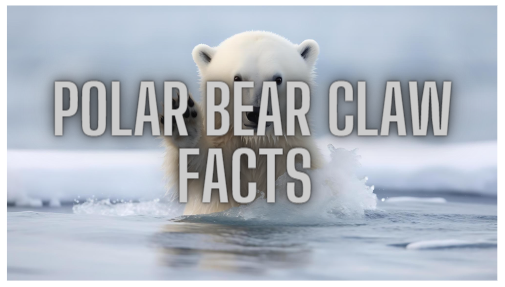Polar bears, the apex predators of the Arctic, possess a range of adaptations that enable them to thrive in their icy habitat. Among their remarkable features are their powerful and sharp claws. In this article, we will explore the fascinating characteristics and functions of polar bear claws, shedding light on how these formidable tools contribute to their hunting abilities, movement on different terrains, and overall survival in the harsh Arctic environment.
Anatomy and Structure
Polar bear claws are formidable weapons, designed to assist them in multiple tasks essential for survival. Here are some key aspects of their anatomy and structure:
Length and Shape: Polar bear claws are relatively long, measuring around 2 to 3 inches (5 to 7.5 cm) in length. They are curved and slightly flattened, which helps them grip and dig into various surfaces, including ice, snow, and prey.
Retractable: Like other bears, polar bears have retractable claws. This means they can extend and retract their claws as needed. When not in use, the claws are partially hidden within the sheath of skin and fur, protecting them from wear and tear.
Strong and Sharp: Polar bear claws are robust and exceptionally sharp. They are made of keratin, the same material that forms human nails and other animal claws. This allows them to effectively grip and tear through the tough hides and blubber of their prey.
Functions in Hunting and Feeding
The claws of polar bears play a crucial role in their hunting and feeding strategies:
Efficient Hunting: Polar bears rely on their claws to capture and secure their prey. When stalking seals on the ice, the sharp claws provide them with traction and support, preventing them from slipping and enabling them to move stealthily. Once they spot a seal’s breathing hole, they use their claws to break through the ice and snatch their prey.
Powerful Strikes: When attacking their prey, polar bears employ powerful swipes with their front paws, using their sharp claws to strike and incapacitate their target. The claws act as effective weapons, capable of inflicting deep wounds and immobilizing their prey.
Efficient Feeding: After a successful hunt, polar bears use their claws to strip the blubber and flesh from the carcass. The sharpness of their claws allows them to efficiently tear through the tough skin and access the nutrient-rich meat. This ability is crucial for maximizing their energy intake and survival in the resource-scarce Arctic environment.
Adaptations for Arctic Environment
Polar bear claws are specialized adaptations that facilitate movement and survival in the Arctic:
Effective Grip on Ice: The curved and sharp claws of polar bears provide them with an excellent grip on the slippery surfaces of ice and snow. This adaptation allows them to traverse the Arctic landscape with relative ease, whether it’s walking on thin ice, climbing out of freezing waters, or navigating steep slopes.
Efficient Digging: Polar bears use their claws to dig dens in the snow, where they can shelter, rest, and rear their cubs. The powerful claws enable them to excavate deep tunnels and create a secure den for protection against the harsh Arctic conditions.
Swimming and Paddling: While polar bears are primarily associated with icy environments, they are also proficient swimmers. Their claws come into play during swimming, as they use them in a paddling motion to propel themselves through the water. The claws act as efficient paddles, assisting in their aquatic movements and allowing them to cover significant distances in search of food or new habitats.
Final Thoughts
The powerful and sharp claws of polar bears are crucial adaptations that aid their survival in the Arctic. From hunting and feeding to navigating icy terrains and excavating dens, these formidable tools serve a range of purposes. The remarkable capabilities of polar bear claws highlight their resilience and effectiveness as apex predators in one of the world’s most hostile environments.

